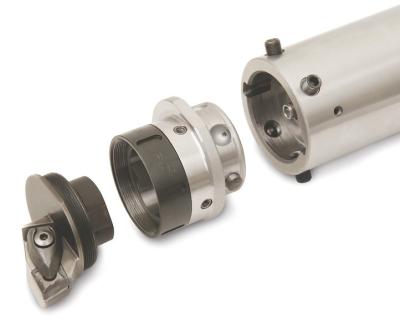
Seco Tools has expanded its Steadyline vibration-damping tooling system to include large-diameter turning/boring bars that provide a reliable, plug-and-play solution for increased productivity in large and deep bore operations. The new 2.36" (60 mm) and 3.15" (80 mm)-diameter sizes are ideal for use in oil and gas applications, as well as general machining of workpieces that require tool overhangs of up to 23.62" (600 mm) or 31.50" (800 mm), respectively.
The Steadyline large-diameter turning/boring bars feature a BA connection and incorporate a BA adapter to mount GL50 turning heads. Seco says its patented and versatile GL connection features a polylobe taper-face interface for centering accuracy, 100 percent repeatability and fast tool head exchanges. The GL connection allows shops to perform both static and rotating operations with the same bar.
The advanced vibration damping system of Steadyline tooling absorbs vibrations before they spread through the bar. Once a turning bar is set, users can mount and remount tooling heads without having to reset the tool.
Steadyline is available in 6xD, 8xD and 10xD bar sizes and in a range of types, including Seco-Capto C6, C8 and HSK-T. The system also features compact boring heads with the GL connection and both the bars and the heads feature coolant supply channels that optimize chip removal.
Contact Details
Related Glossary Terms
- boring
boring
Enlarging a hole that already has been drilled or cored. Generally, it is an operation of truing the previously drilled hole with a single-point, lathe-type tool. Boring is essentially internal turning, in that usually a single-point cutting tool forms the internal shape. Some tools are available with two cutting edges to balance cutting forces.
- centering
centering
1. Process of locating the center of a workpiece to be mounted on centers. 2. Process of mounting the workpiece concentric to the machine spindle. See centers.
- coolant
coolant
Fluid that reduces temperature buildup at the tool/workpiece interface during machining. Normally takes the form of a liquid such as soluble or chemical mixtures (semisynthetic, synthetic) but can be pressurized air or other gas. Because of water’s ability to absorb great quantities of heat, it is widely used as a coolant and vehicle for various cutting compounds, with the water-to-compound ratio varying with the machining task. See cutting fluid; semisynthetic cutting fluid; soluble-oil cutting fluid; synthetic cutting fluid.
- turning
turning
Workpiece is held in a chuck, mounted on a face plate or secured between centers and rotated while a cutting tool, normally a single-point tool, is fed into it along its periphery or across its end or face. Takes the form of straight turning (cutting along the periphery of the workpiece); taper turning (creating a taper); step turning (turning different-size diameters on the same work); chamfering (beveling an edge or shoulder); facing (cutting on an end); turning threads (usually external but can be internal); roughing (high-volume metal removal); and finishing (final light cuts). Performed on lathes, turning centers, chucking machines, automatic screw machines and similar machines.

